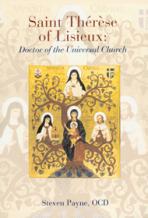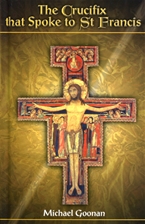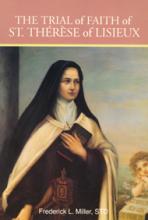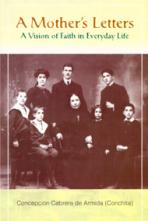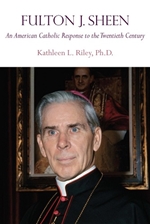Customer Reviews

SAINT THRÉRÈSE OF LISIEUX - Out of Stock
Description
SAINT THRÉRÈSE OF LISIEUX
Doctor of the Univeral Church
Author: Steven Payne O.C.D.
Copyright: 2002
First Printed: 11-25-2002
On World Mission Sunday, October 19, 1997, Pope John Paul II declared St. Thérèse of Lisieux a “Doctor of the Universal Church.” This event marked not only the culmination of an unprecedented series of honors bestowed on “the greatest saint of modern times,” as St. Pius X called her, but it also represented a watershed in the evolution of the understanding of this ecclesiastical title bestowed on only thirty-three saints in the history of the Church. Certainly, at the time of her death in 1897, no one would have guessed that this 24-year-old Carmelite nun, with such a limited education and imperfect literary style, who never wrote a treatise or published an article and who died virtually unknown in an obscure French Carmel, would one day come to be ranked alongside such eminent personalities as St. Augustine and St. Thomas Aquinas as a doctor ecclesiae. Her selection did not come about in a vacuum, nor did it happen easily. The story behind the title and her reception of it as documented in these pages makes for truly fascinating and thought-provoking reading.
About the Author: Steven Payne, OCD, is a priest of the Washington Province of Discalced Carmelite friars. He is past editor of Spiritual Life magazine and ICS Publications and the author of numerous works in philosophy of religion, theology, and Carmelite spirituality. He has taught at the Weston School of Theology in Boston, at the De Sales School of Theology and Washington Theological Union in Washington, DC, and most recently at Tangaza College and the Catholic University of Eastern Africa in Nairobi, Kenya. He is the current president of the Carmelite Institute in Washington, DC.
Book: 256 pages
ISBN-10: 0-8189-0923-4
ISBN-13: 978-0-8189-0923-8
Prod. Code: 0923-4
Reviews
"October 19th, 1997 was a red-letter day for Carmelite spirituality. On that day, World Mission Sunday, John Paul II declared Thérèse of Lisieux a 'Doctor of the Universal Church.' This notable event crowned an unprecedented series of honours bestowed on 'the greatest saint of modern times,' as she was called by Pius X. It also marked a watershed in the Church's understanding of the title, 'Doctor of the Church.' This book describes the life and teaching of Thérèse and, in fuller detail, the events that led up to her being numbered among the great Doctors of the Church.
At the beginning, the author gives the scriptural and patristic background to this unique honour. Speaking of the early Christian charisms, Paul puts doctors in third place after apostles and prophets (1 Cor 12:28). According to the future Benedict XIV (when 'promoter of the faith' in the Congregation of Rites), three things are necessary for someone to be declared a Doctor of the Church. These are (i) eminent doctrine; (ii) outstanding holiness of life; (iii) a declaration by the supreme pontiff or a legitimately convened General Council. Thérèse easily meets these three traditional standards. She does even more. She adds her own personal approach to holiness and gives truth a new radiance that marks her out as a great and gifted teacher.
John Paul II pointed this out clearly in his homily to mark the occasion. In choosing as a Doctor of the Church this young woman--who died at twenty-four and was unable to attend any university or engage in strict systematic study--the Church was departing from tradition and breaking new ground. We do not find in Thérèse any learned discourses or a deep scholarly presentation of the things of God. What we do find, in her school copybook, is something much more vital and valuable: a way of truth illumined by love. We find a new form of wisdom, unique in clarity and conviction. It is a wisdom in full conformity with the sources of revelation but it excels in its simplicity, depth and discernment. It touches the chords of the soul. Paul says, in his First Letter to the Corinthians, 'We teach spiritual things spiritually' (2:13). So, too, does Thérèse.
In the last chapter, the author traces the rays of light which shine from her wisdom on some of the great truths of our religion--the mercy of God, the love of Christ, the power of prayer, the place of suffering and the role of our Lady. All of these she touched, illumined and enriched. No wonder she is said to have been an invisible, heavenlyperitus at Vatican II, particularly in the Council's call for a return to Sacred Scripture and its emphasis on the universal call to holiness.
I enjoyed reading this book and found it helpful, informative and very inspiring. All lovers of Thérèse should read it. They will find new inspiration from her writings and can await with confidence further signs of her power in heaven as she takes up her new mission as a Doctor of the Universal Church." --Ambrose McNamee, OCD in Mount Carmel, Oxford, England - June 2004
"Picking up Saint Thérèse of Lisieux and paging through its table of contents, one's first impulse may be to put it down again because it seems so technical. But readers who persevere will find the book a fascinating guide to the little-known process by which the Church bestows one of its highest honors on a saint. Father Steven Payne is an editor, writer, teacher, and expert in spirituality. In 1997 his Order, the Discalced Carmelites, asked him to research the impact Thérèse of Lisieux has had on Catholics in North America. While doing so, he received the working papers from a commission investigating the possibility of naming her a Doctor of the Church. Only thirty-three saints have been so honored. Father Payne tells us what this honor means and how it has developed in the Church. We are then led through the careful process by which a saint is named a Doctor of the Church. The main focus of the book examines that process. But we are also enlightened about the life of Thérèse of Lisieux, and we learn her "eminent teaching," that is, why she was singled out for this particular honor. The book seems to be written for theologians and researchers. Yet pastors, catechists, and the average person will find it a unique view into the inner workings of this part of Church administration. Catholics can be proud of the professionalism and care with which a candidtate is declared a Doctor of the Universal Church." --Gary Lauenstein, C.Ss.R. in Liguorian, April 2004
"This monograph, originally a doctoral dissertation at the Catholic University, is an important addition to theological libraries for several reasons. First, it provides a thorough overview of the historical development and contemporary state of processes for designating 'doctors of the Church.' Second, it traces in detail the process involved in the caseof St. Thérèse of Lisieux, including all the arguments that were offered for and against her doctorate. Third, it summarizes and evaluates Thérèse's theological contribution. Finally, it includes a select bibliography of serious theological studies of Thérèse and of other topics related to her doctorate.
Even apart from the specific question of Thérèse's doctorate, this study offers valuable insight into how the communal body of the Church reflects, debates, and decides on such questions. The final process of deciding about Thérèse's doctorate was a 'rush job,' with all the documents compiled, all the theological opinions solicited, and all the votes held between February and June of 1997 (the centenary of her death). However, this must be put into perspective in that a serious movement for her doctorate had begun in the 1920's and had consistently garnered widespread popular and episcopal support.
A major reason for the delay of the final official process was that the Congregation for the Doctrine of the Faith was working on a revised list of criteria for the doctorate, which was not completed until November 1996. Payne reviews the entire process, including the early grassroots movements, various theological opinions through the decades, and the opinions given by each of the thirty-four theologians and consultors during the official process. Despite the rush at the end, there was probably a wider reflection process and a more carefully defined set of criteria in this case than in that of many other doctors of the Church.
For those opposing Thérèse's doctorate, the primary issue was whether her doctrine is appropriately 'eminent.' A frequently expressed concern was whether making her a doctor means that every saint can be a doctor. Payne does a masterful job of exploring this issue, allowing opposing voices their full say while showing how the deeper issue is a church-wide re-evaluation of the character and role of theological reflection. In the deceptively simple form of autobiographical storytelling, Thérèse carefully thought through important theological issues by reflecting on ordinary life experience in the light of Scripture, magisterial teachings, and major spiritual classics. The fruits of this methodology have clearly been 'received' by massive numbers of the faithful as well as by many bishops and some theologians. In the new criteria, factors such as the reception, pastoral impact, timeliness, and freshness of a saint's doctrine are recognized as even more important indicators of 'eminence' than its systematic character or intellectural brilliance.
At the same time, this does not eliminate the requirement that the candidate offer genuine 'doctrine' of a theological character, which many great saints do not. In the final chapter Payne summarizes Thérèse's key theological contributions in relation to contemporary developments in systematic theology. Hans Urs von Balthasar, among others, has asserted that Thérèse's mission was 'primarily theological' (187). Her central insight, says Payne, was 'the gradual recognition of her own radical weakness as creature and her accompanying "rediscovery"... of a God who is all Merciful Love, who calls her to reciprocate that love "infinitely" by surrendering with the confidence and "abandonment" of a child to the activity of God's love within her, in the smallest details of her life' (169). This core insight, which radiated through all her life and thought, has yet to be fully received and reflected upon by systematic theologians.
Payne, who is a Discalced Carmelite friar with doctorates in both philosophy and theology, clearly engaged this study with a favorable attitude toward Thérèse's doctorate. Nonetheless, the best word to describe his approach is 'balanced.' He is able to critique and appreciate the insights of those who favored the doctorate and those who opposed it. His overall goal, I believe, was to underdtand in depth the 'mind of the Church' as it worked toward and affirmed this decision. It will be especially valuable reading for theologians and others who find Thérèse's doctorate puzzling." --Mary Frohlich, R.S.C.J., Catholic Theological Union, in New Theology Review
Many reasons have been adduced for the public's lavish response to the popularity of St. Thérèse of Lisieux: her physical beauty (photographs show a pleasing, full-cheeked face with brooding eyes); her romantic death; her floral imagery; her native energy and kindness; her dazzling promise to spend eternity saving earthly souls, confirmed in the eyes of many by the bumper crop of reported miracles connected to her intercession; her doctrine of the Little Way, which laid out a path of sanctity in the midst of ordinary life. In any event, it is the last that led John Paul II in 1997, the centenary of her death, to proclaim Thérèse a doctor of the Church, only the third woman (after Teresa of Avila and Catherine of Siena) and thirty-third saint to be so honored. To understand why and how this happened, and, in the process, to help explain Thérèse's universal appeal, is the aim of Steven Payne's Saint Thérèse of Lisieux: Doctor of the Universal Church.
Payne's work lacks a certain intimacy and simplicity... His manner is formal and understated. Nonetheless, Payne's book draws one in, in part because its topic has generated some controversy: after all, Thérèse was neither a scholar nor a theologian; her schooling was limited; she published nothing during her life; her writings suffer from surface naivete and a penchant for overblown metaphors. Why, then, should she rank alongside Augustine, Aquinas, and Anselm as a doctor ecclesiae?
Payne begins, in workmanlike fashion, by recounting the etymological history of the title. The term "doctor" emerges in the Pauline letters of the Vulgate, as a translation for the Greek "teacher." A doctor is one who transmits the gospel, teaching by word and example. During the patristic era, it became an honorific attached to those outstanding in evangelical skill and zeal. During the eighth century, the Venerable Bede crowned four men -- Ambrose, Augustine, Gregory, and Jerome -- with the title, a choice officially ratified, a half-millennium later, by Boniface VIII's bull of 1298. This handful of doctors soon became a multitude, as Aquinas, Bonaventure, John Chrysostom, Basil, Gregory Nazianzen, and others joined the ranks. The list, now thirty-three strong, ranges from the famous (Bernard of Clairvaux, John of the Cross) to the obscure (Ephraim the Syrian, Lawrence of Brindisi). All satisfy the three defining criteria of outstanding holiness, eminence of doctrine, and an official proclamation by pope or general Church Council.
Does the Little Flower meet these qualifications? From the very beginning, she had her advocates: the abbot of Gethsemane Abbey in Louisville, Kentucky, seems to have been the first to propose her for the doctorate, just three years after her canonization. The first worldwide petition circulated in 1932 and gathered, within a year, the signatures of 342 bishops. Prominent theologians such as Erich Przywara, Yves Congar, and Hans Urs von Balthasar championed Thérèse's mission and detailed her contributions to theology and spirituality. Nonetheless, the drive stalled, the reason, as Pius XI tersely remarked, being "obstat sexus." But in 1970 Paul VI named as doctors two women, Teresa of Avila and Catherine of Siena, and the wheels began to turn for Thérèse....
The experts had no difficulty dealing with the first doctoral criterion of outstanding sanctity. To a man (and one woman) they praised Thérèse's radiant holiness, agreeing that her humility, her goodness, her integrity, her radical submission to God's will, set upon her unmistakably the seal of sanctity.... Far more vexing was the second criterion, that of "eminence of doctrine." According to precedent, the candidate must bring to the theological table a teaching that is original, profound, faithful to tradition, and of strong and lasting influence. But did Thérèse have any doctrine at all to offer the Church?
A consensus developed that Thérèse did fulfill the requirement -- but only with a caveat. One must first acknowledge that a new kind of doctor has emerged in the Church, a master of spirituality rather than theology, and that the definition of doctor ecclesiae must evolve to keep pace. The cases of Francis de Sales (proclaimed doctor in 1877) and Anthony of Padua (1946) initiated this new understanding; Thérèse confirmed it.This granted, her preeminence becomes apparent. Her Little Way, with its radical insistence upon childlikeness and absolute love, constitutes an original and profound elaboration of gospel principles. The influence of her doctrine is enormous and seems likely to last Austria's Christoph Cardinal Schönborn, the most distinguished of the seven theologians to examine the case, argued in the Positio that Thérèse's mission came directly from God and that it has "changed the climate of the Church" through its definitive rejection of Jansenism in favor of the "Mystery of God who is Love." That Thérèse accomplished this largely through the example of her personal sanctity constitutes her particular "charism of wisdom." John Paul II, during his homily for the October 19, 1997 Mass proclaiming her a doctor, confirmed this perspective by observing that "it is precisely this convergence of doctrine and concrete experience, of truth and life, which shines with particular brightness in this saint."
In Divini Amoris Scientia, his apostolic letter announcing the doctorate, the Pope goes even further, Thérèse was a master of "the science of divine love" who "experienced divine revelation," "knew Jesus," and "penetrated the mysteries of his infancy," making her "a living icon" of God. Moreover, the Pope adds, Thérèse's Little Way is at once "unique" and "the most basic and most universal truth." She thus draws from the wellsprings of the gospel and prepares the future harvest of the Church. Adding his own coda to this crescendo of praise, Payne suggests that Thérèse's writings may be taken as a model for a new kind of theological reflection, deeply rooted in Scripture and tradition, that yields fundamental insights -- witness her "rediscovery" of the God of infinite mercy or her revolutionary idea of heaven as a place, not only of beatific vision, but of earthly activity. Thérèse proves to be not only a saint, but, in Balthasar's memorable phrase, a saint who practices "theology on its knees." --Philip Zaleski, "The Love of Saint Thérèse" in First Things, December 2004
"Father Seven Payne, O.C.D., the president of the Carmelite Institute of Washington, D.C., has written an interesting book detailing the steps leading to the declaration of St. Thérèse of Lisieux to ba a doctor of the Church by Pope John Paul II on Oct. 19, 1997. A year before, the Congregation for the Doctrine of the Faith published six requirements that need to be met before a saint might be declared a Doctor of the Church (pages 79 and 80). The author then sets out to show how the writings of St. Thérèse meet these criteria. While this would seem to make for dull reading, I found it not the case. Father Payne situates St. Thérèse's writings in her life and traces how the early editing has been removed from the texts to better reflect the thought and sentiment of the original manuscripts. He then discusses at length the theological import of her contribution. I enjoyed this book better than I thought I would. It provides an intellectual appreciation for the legacy of this great saint and her significance in our Church." --Rev. Don Piaro in The Priest, April 2003





